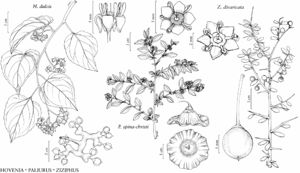Paliurus
Gard. Dict. Abr. ed. 4, vol. 3. 1754.
| Taxon | Illustrator ⠉ | |
|---|---|---|
 | Ziziphus obtusifolia Hovenia dulcis Paliurus spina-christi | Yevonn Wilson-Ramsey Yevonn Wilson-Ramsey Yevonn Wilson-Ramsey |
Shrubs [or trees], sometimes clambering, armed with stipular spines; bud-scales present. Leaves deciduous [persistent], alternate; blade not gland-dotted; 3-veined from base (acrodromous), secondary-veins distal to basal veins well developed. Inflorescences axillary, cymes; peduncles and pedicels not fleshy in fruit. Pedicels present. Flowers bisexual; hypanthium hemispheric to patelliform, 2–3 mm wide; sepals 5, spreading, pale-yellow, deltate, keeled adaxially; petals 5, white, hooded, obovate, clawed; nectary fleshy, filling hypanthium, margin entire or 5-angled; stamens 5; ovary 1/2-inferior, 2–3-locular; styles 2–3, connate proximally. Fruits samaras. x = 12.
Distribution
Introduced; Tex., Europe, e Asia
Discussion
Species 5 (1 in the flora).
The fruit of Paliurus was described by C. Schirarend and M. N. Olabi (1994) as a dry, indehiscent drupe. The gynoecium base in Paliurus begins to swell laterally following fertilization, forming a persistent, disciform, cupulate, or hemispheric wing of varying thickness (D. O. Burge and S. R. Manchester 2008). This enlarged and winglike receptacle is diagnostic of the genus.